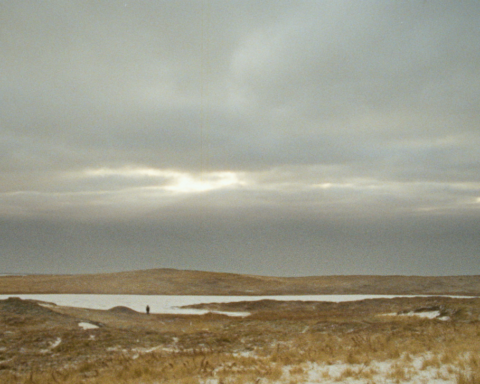POV asked contributing editors Janis Cole and Noelle Elia to offer their assessments on the career of documentary veteran Bonnie Sherr Klein, who recently returned to filmmaking after years adjusting to life with a disability. At the time of her strokes, Klein was a prominent director, who had made one of the NFB’s most significant and divisive films, Not A Love Story , for the Board’s famed women’s unit, Studio D. Here, from contrasting points of view, are two looks at an important Canadian filmmaker.
Former NFB Studio D filmmaker Bonnie Sherr Klein is widely considered to be one of the studio’s most renowned feminist filmmakers. Not A Love Story: A Film About Pornography (NALS) is her signature film. The NFB promotes it as one of its most successful films of all time. It is also among its most controversial, partially for using the very images it denounces; and partly because it has, from the beginning, caused both fierce alignment and rejection of its central message.
In 1987 Klein’s life and work were irrevocably altered by two sudden strokes that radically changed her mobility and propelled her into a new form of activism on behalf of the disabled. She published a moving account of her experience in Slow Dance: A Story of Stroke, Love and Disability (1997). The book is a testament of her great will and spirit to live life fully. Primarily a recollection of her personal journey through illness and recovery, she chronicles the shortcomings and attributes of going through the healthcare system. She pulls in multiple perspectives along with her own: her husband Michael’s, son Seth’s, daughter Naomi’s, extended family members’, friends’, co-workers’, nurses’ and doctors’, and in doing so takes the reader straight to the heart of every dramatic up and down.
After a 17-year hiatus from filmmaking, Klein recently pointed the camera on herself and a group of disabled artist friends to make Shameless: The ART of Disability (2006). She claims this will be her final film because she finds the physical tasks of filmmaking have become too exhausting. Klein has earned numerous awards for her film work, and was granted an honorary doctor of laws degree from Ryerson University. She lives with her husband in British Columbia and continues her activism on behalf of the disabled.
A Shameless Love Story: Janis Cole’s POV
Not A Love Story: A Film About Pornography (NALS) (1981) premiered at the Toronto Film Festival the same year my first feature doc P4W: Prison for Women showed there. I remember the controversy surrounding Klein’s film, including Globe and Mail critic Jay Scott calling her a “bourgeois, feminist fascist.” Klein’s worldview and point of view are intricately intertwined, but why slur the filmmaker when the flaws of NALS rest in filmmaking devices that could have worked, but backfired?
In the film, Klein admits to not knowing the pornography world when she starts out. She enlists a stripper named Lindalee Tracey, presumably to both validate her entrée into the sex world, and to introduce tension into the narrative through Tracey’s opposing point of view. Klein holds a belief that women who engage in sex for economic reasons are victims, while Tracey claims her power as a stripper, denouncing Klein’s view—at least initially. Tracey performs her strip show in the film and poses for a close-up photo shoot of her pussy, flamboyantly orchestrated by Hustler photographer Suze Randall.
Klein’s embrace of the “real deal” stripper includes bringing her into the fold and supplying a credit that reads, “made in association with Lindalee Tracey”—not a common credit, presumably meaning Tracey shared creative involvement and final approval. Tracey, the sex-positive stripper, traverses the film like an adjunct filmmaker, getting increasingly drawn into the filmmaker’s stratagem to convert her way of thinking. Both Klein and Tracey play roles: the filmmaker embracing the stripper’s know-how, and the stripper leading the way for the filmmaker, and both performances ring false.
When Tracey finally converts to Klein’s view, she loses all credibility as the (s)expert. She reads a self-written passage aloud to Klein, and becomes weepy recalling how she felt objectified after the Hustler photo shoot. The film is structured to make this Tracey’s “character arc.” Set at the beach, the backdrop metaphorically implies the changing tide around them. The scene feels staged even though it’s played for the camera in vérité style.
I question who is more complicit for the failure of Tracey’s role in the film, Klein who engaged her as the “voice of authority” and then positioned her to lose it, or Tracey who allows her position to get lost in the filmmaking process? They are equally responsible. Klein shows poor judgment in wanting Tracey to change, and Tracey “performs” the change for the camera then accepts it in the final cut. If she did not want her character change to be part of NALS, the time to say so was then.
Tracey initially helped Klein promote the film, which I remember well. When criticism piled up amidst the accolades, Klein remained attached to the film while Tracey started to distance herself. In a recent POV interview, Tracey said that she found the whole experience (of Not A Love Story) incredibly painful, untrue and inauthentic. Klein, however, recalls a good working relationship that soured a year after the film was released. She was hurt by Tracey’s refusal to discuss the problem and has never understood why it occurred. The controversy around Tracey’s role has plagued the film from its inception, and escalated over time. But history does not change, people change. Fair enough. Another technique I question in Not A Love Story is Klein’s reliance on cutaways – 40 altogether – of herself, Tracey or the two of them together. By inserting their nods of agreement and shakes of disbelief, and making these reactions look as though they are part of the live action with other participants, which is how Klein uses them, she discredits their use entirely. Nothing demeans a doc faster for me than employing an unauthentic voice of authority or inserting cutaways meant to tell me how to think. Klein does both in NALS.
In 1989, Klein and I were part of a delegation of Canadian women filmmakers in Israel. It was shortly after her intense rehabilitation from two life-threatening strokes. Klein’s wheelchair led us through the narrow streets of Jerusalem after lunch one day and we all admired her stamina. Years later, we would witness her social feminism shift to include outspoken activism on behalf of the disabled. After a long hiatus Klein recently released Shameless: the ART of Disability (2006). A labor of love, Shameless is an upbeat doc that celebrates the productive lives of five disabled artist friends. Klein figures predominantly in the NFB production.
Shameless bursts with heart and has a powerful message, especially in expressions of love between Klein and her husband Michael, and between other characters and their sweethearts. They speak of deep love, unhindered by immobile bodies or distorted faces. I wasn’t surprised that the characters in the film lead full lives and have brilliant minds, but learning of their rich, intimate love lives was a wonderful discovery. If Klein intended a positive worldview of her subject, she succeeds resoundingly—love is universal, for folks in all walks of life.
Not A Love Story is the first widely screened documentary on pornography. Shameless is the first doc about the disabled by the disabled. Neither film is definitive, but both are historically relevant. While NALS shamelessly perpetuates a narrow viewpoint of pornography that gets more outdated over time, Shameless unabashedly conveys stories of love that will undoubtedly become timeless.
“She said”: Noelle Elia’s POV
The first time I met Bonnie Sherr Klein she was reclining on a couch in a classy hotel, wrapped in a raspberry-colored chenille blanket —accomplished cineaste en repose. In town last October to present her latest documentary, Shameless: The ART of Disability, at ARCfest, Toronto’s social justice arts festival, she discussed her return to filmmaking and how she’d “learned finally to just be.” Unlike many, I’d never seen her films and knew more about her equally accomplished daughter Naomi Klein than I did of her. Two years ago, I came across Not a Love Story online while researching another POV article. When I learned of its staunch anti-porn stance, and that it had been banned in Ontario for its pornographic content, I wrote it off. Admittedly, that brusque brush-off was a lapse in objectivity from my pro-porn perspective. And only recently did I learn that twenty years ago, Klein’s life had changed forever.
Approaching her “three stage” career with virgin eyes, I intentionally worked backward from present to past to find out who Klein is now so as to better understand who she was then. I watched Shameless, then read Slow Dance, and topped it off with the ever-polarized Not a Love Story (NALS). Vietnam War resister, feminist, Challenge for Change and Studio D filmmaker, writer, radio documentary producer, stroke survivor and disability rights activist, clearly this woman has done her fair share. Given that we come to our personal politics at different stages of individuation, during different periods in history, and are influenced by countless variables, I was curious to discover how she’d evolved creatively.
In the crowded foyer of The Workman Theater, Klein maneuvered her scooter, Gladys II, around the wheelchairs, walkers, canes and seeing-eye dogs. For the hearing impaired, Shameless was subtitled and a sign language interpreter participated in the lively, thought- provoking Q&A. On stage, Klein was joined by co-star and “disability guru” Catherine Frazee. Whereas NALS had a distinct whiff of righteousness about it, Shameless spoke from a more empowered, albeit hard-won, place. How could it be otherwise? Klein had literally faced near-death and lived to tell the tale. She’s appropriately dubbed this doc, “a picture of the possible.” By broadening the story’s scope to include four other dynamic, disabled artists (their so-called “company of crips”), Shameless is intimately and, according to Klein, “gently subversive.”
Stylistically, however, Not a Love Story surpasses Shameless. The grainy, textured tones of the former translate better than the latter’s video production values. Or maybe I’m just waxing nostalgic for the “authenticity” of those sleazy peep shows—gaudy and beautiful to my eye—that have all but disappeared from our homogeneous urban landscapes. While my politics matured during the early ’90s sex-positive movement when the likes of Susie Bright, Carol Queen and Annie Sprinkle mixed sex with wit, deviance with irreverence, “kids today” are over-stimulated, under-read, desensitized, derisive and acutely media savvy. American teen queens act out like porn stars as a matter of course. NALS harkens to a fundamental period in feminism, replete with accelerated growth amid co-existing contradictions. Even if the documentary feels unbalanced (not all porn is misogynistic), its relevance endures as a signpost from the ’80s “Feminist Sex Wars.”
The question of whether the late Lindalee Tracey was exploited in NALS remains unfinished emotional business. On-screen, she comes across as an articulate, feisty, fully consenting participant who questions, listens, proclaims and questions again. More an erotic performance artist than your average “peeler,” Tracey embarks on a journey with Klein to reconcile mixed feelings and messages about the über-sexualized, and often demeaning, representation of women by, and for, men. Since the only way to affirm your principles and politics is to test them out in reality, Tracey agreed to do this on camera—including the climactic Hustler photo shoot. Ultimately, I admire her willingness to test her beliefs—regardless of the outcome—in the name of greater self-awareness.
Six years after NALS was released, Klein faced her own enormous test that eventually bore much fruit. From an invisible twist of genetic fate, Klein suddenly became the marginalized, misrepresented “other” who had so often been the subjects of her films. She had to re-build from scratch. Her memoir of healing, Slow Dance, is a compelling page-turner, an incredible love story, and a lesson in courage and resilience. What’s truly remarkable is her ongoing self-realization as an artist. The lessons she learned from her early films on social justice, the peace movement and sexual politics became part of the foundation that supported her through a life-threatening illness, a long rehabilitation, and the frightening abyss of an identity revolution. The same strength that propelled her into the disability rights movement encouraged her eventual return to filmmaking.
2006 marked the 25th anniversary of Not a Love Story and, along with Shameless, was celebrated at last year’s prestigious Margaret Mead film festival in New York. Lately, Bonnie Sherr Klein has noticed her focus shifting toward Israel and Judaism. Illness awakened a dormant spirituality and she now identifies strongly with the concept of tikkun olam, translated from Hebrew as “repairing the world.” In actuality, Klein’s been an exemplar of tikkun olam for over forty years. Mazel tov!
Blurring Boundaries: Janis Cole responds to Noelle Elia
In an exemplary career of vast achievement there exists one major blemish in Bonnie Klein’s working life that may, in all likelihood, never be healed. Days after I delivered my first installment, Bonnie contacted POV to have her perspective of her relationship with Lindalee Tracey considered.
She tells me Tracey was paid for participating in NALS and promoting the film initially. She gave Tracey editorial control over her image and showed her the cut at various stages, and before completion. Tracey’s cutting room inclusion indicates more than your average doc subject participation. Crediting Tracey as a creative “associate” indicates they each realized what the film makes evident: NALS would not be what it is, for either of them, had it not been for their shared teamwork.
Klein was a seasoned filmmaker when she enlisted Tracey, a savvy stripper, to explore the sex world with her, test their views off each other, and form the narrative jointly. Klein was positioned to guide their professional relationship when she “cast” Tracey as both the sex-world “star” of NALS and her onscreen collaborator. Klein’s inclusive authorship approach may have blurred boundaries for an unseasoned documentary participant.
Having studied the film again, I question a feminist politic that didn’t embrace big-heartedly Tracey’s co-authorship. Bonnie went on to say, “I do not disagree with Lindalee’s heartfelt feelings like shame and humiliation” (about NALS at the end of her life). But that’s not what Tracey conveyed, she expressed anger about untruths, and that’s how she left this earth.
Watching Klein and Tracey on-screen it’s not difficult to imagine Not A Love Story: A Film About Pornography made by Bonnie Sherr Klein and Lindalee Tracey. Providing a posthumous credit is a munificent gesture and, granted, would not alleviate the film’s anti-pornography message, which Klein and Tracey share equally in creating, but it would go a long way toward mending a dispute that has plagued the film for twenty-five years.
While NALS is the pinnacle work in Klein’s accomplished career, her entire collection is available to the public through the NFB, including the delightful Shameless. Undoubtedly there is more work on the horizon from this tireless maverick, even if not by way of film.
Noelle’s response:
Your views on Klein’s work are insightful. They’re also heavily informed by your experience of the controversy surrounding Not a Love Story. I neither knew Lindalee Tracey nor was around for the dramatic fallout; I can only gauge the film within its greater dialectical context. Flawed, yes. Dated, ditto. But I’m hesitant to condemn it as I originally did—it’s simply implicit of its time. Re-contextualized, anything can look different in another decade’s light. I don’t feel there’s any “failure of Tracey’s role in the film” because my response to the core issues doesn’t hinge on her so-called transformation. I also don’t buy that when she “finally converts to Klein’s view, she loses all credibility as the (s)expert.” Thorny subjects like identity politics, feminism and pornography resist easy reductionism. Individual and socio-political paradigm shifts are inherently problematic. And growth spurts are always subject to growing pains. Yes, the documentary wraps up a little too neatly but, twenty-six years later, why continue shooting the messenger (be it Klein or Tracey) just because the message is messy, even manipulative?
Instead, I’m more interested in Klein’s evolution as an artist. As Herbert Marcuse once said, “Art functions as the conscience of society.” Art can challenge beliefs and effect change. Watching and talking about Not a Love Story is as relevant today as is the screening and distribution of Shameless —to see not only how far we’ve come, but also to recognize that we’re on the path to healing cultural disabilities such as prejudice and inequality. Since the ’60s, Klein’s work has consistently reflected her life concerns. Illness and rehabilitation ripened and broadened her creative voice making it more heart-centered and regenerative. Given society’s existential ills, the focus on loving relationships, creativity and community in both Slow Dance and Shameless is radically, perennially au courant.
Selected Filmography:
Organizing For Power: The Alinsky Approach (1968) A series of five films (Dir. & Co-Dir.)
A Working Chance (1976)
Patricia’s Moving Picture (1978)
The Right Candidate for Rosedale (Co-Dir.) (1979)
Not a Love Story: A Film About Pornography (1981)
Speaking Our Peace (Co-Dir.) (1985)
Shameless: The ART of Disability (2006)











